Arrowhead plants have lush, arrow-shaped leaves and a trailing growth habit. Whether you’re a seasoned plant enthusiast or a beginner, arrowhead plant care is simple and rewarding.
This indoor plant starts out as a compact, bushy plant, but over time, it will develop long vines, making it ideal for hanging baskets.
Arrowhead plants are versatile and adapt well to a variety of indoor environments. With regular watering and occasional pruning, they will produce new growth continuously.
Keep reading to learn how to grow and care for this tender perennial houseplant.
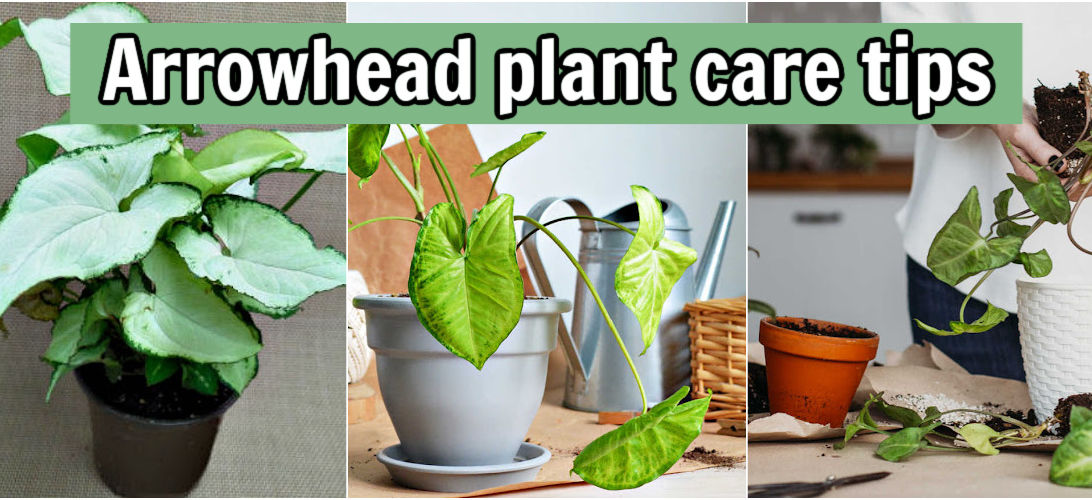
Some of the links below are affiliate links. I earn a small commission, at no extra cost to you, if you purchase through an affiliate link.
Arrowhead plant care
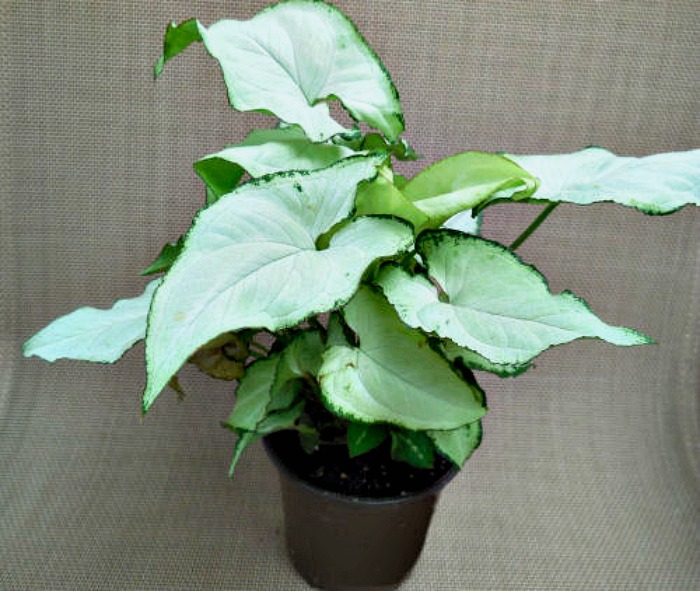
This table gives an overview of the care of arrowhead plants. It highlights their key characteristics, from sunlight needs to pruning and maintenance.
| Common names | Arrowhead vine, goosefoot, African evergreen, American evergreen |
| Botanical name | Syngonium podophyllum |
| Family | Araceae |
| Plant type | Tender perennial, normally grown as a houseplant |
| Sunlight needs | Bright, indirect sunlight |
| Soil requirements | Well-draining soil, rich in organic matter |
| Soil pH | Slightly acidic |
| Bloom time | Summer |
| Flower color | Green to greenish white |
| Hardiness zones | 10-12 USDA |
| Native area | Mexico, Central and South America |
Syngonium podophyllum light requirements
Place your Syngonium houseplant so that it gets bright indirect light. An east-facing window is best. Sunlight can scorch the plant easily.
The variegated varieties can tolerate a bit more sun, while the solid green types of arrowhead plants do well in lower light conditions.
Rotate the plant to ensure that it grows evenly.
When to water arrowhead plants
Water every 2-5 days during the summer to keep the soil evenly moist. Reduce watering in the winter months when the plant is more dormant.

Arrowhead plants like high humidity, so they enjoy having their leaves sprayed with a plant mister. You can also place the plant on a tray of pebbles in water to increase humidity.
Water your Syngonium when the soil becomes dry to the touch about 1 inch into the soil. Make sure not let the soil completely dry out.
Arrowhead plant soil and temperature needs
All Syngonium varieties, including Exotic Allusion arrowhead plant, enjoy a potting soil that drains well. They prefer soil that is rich in organic matter.
Keep the plants in the 65 – 85°F (18 – 27°C) range if possible. The plant loves warmth! These temperatures should be maintained year-round.
Temperatures lower than 50°F (10°C) can kill your plant.
How to fertilize Syngonium vines
Feed this plant regularly with a liquid indoor plant fertilizer during the spring and summer months. No feeding is necessary in the winter when the plant’s growth slows down and it becomes dormant.
Arrowhead plant repotting and pruning
Large arrowhead plants need to be repotted every year or two. When repotting, be sure to choose a pot that is 1-2 inches bigger, to give it enough room to grow.
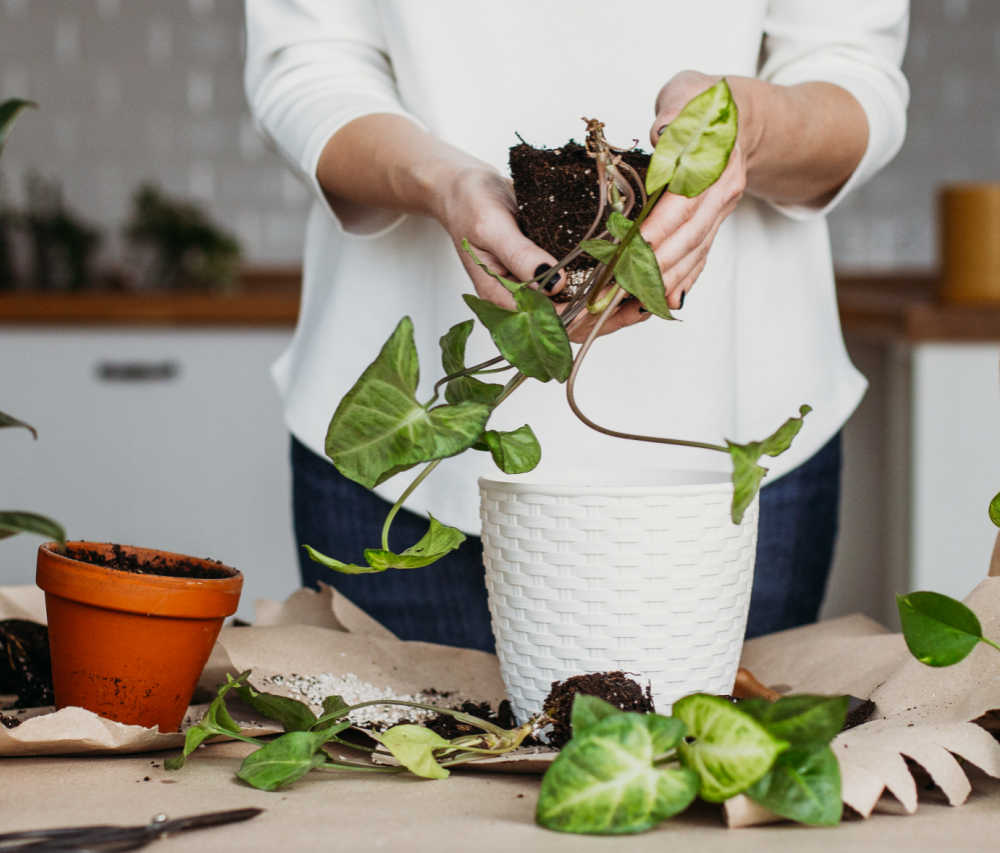
Prune Syngonium plants regularly by pinching the tips. Doing this will encourage new growth and make the plant more bushy.
You can use the pinched tips to propagate new plants.
Propagating arrowhead plant
Arrowhead plants can be propagated from cuttings that will root in both soil and water.
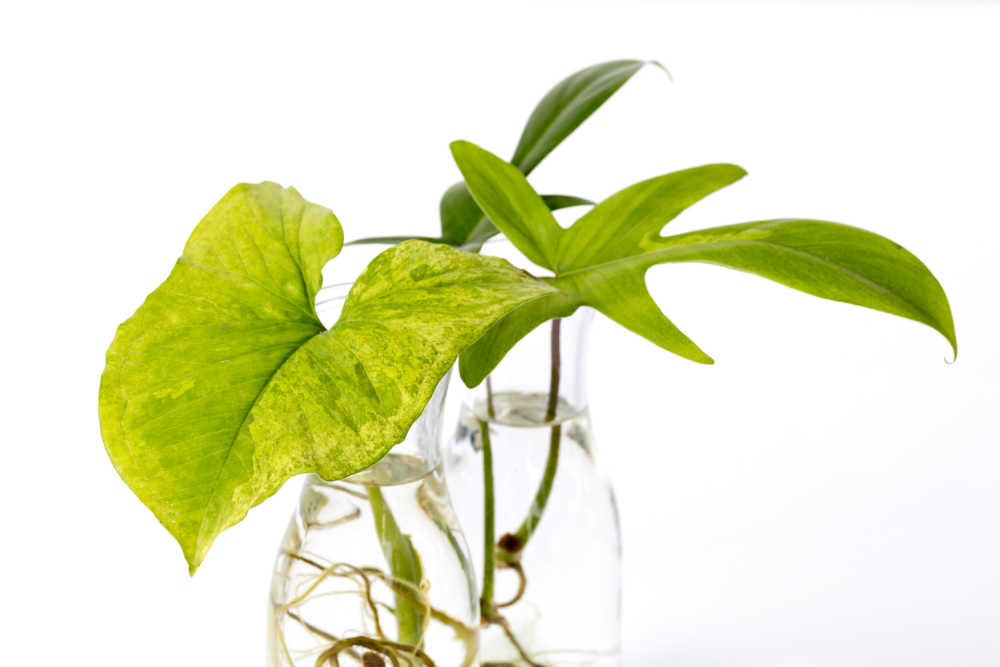
To propagate arrowhead plants in soil, cut a 6-12 inch section of the stem just below a leaf node. Plant the cutting into a moist potting mix.
To propagate Syngonium in water put the stem directly in a container of water. New roots will appear within 1-2 weeks, and new leaves will start growing after about a month.
Arrowhead plant foliage
The leaves of Syngonium are spade-shaped or arrowhead-shaped, which gives it one of its common names.

The leaves change shape as the plant grows. The juvenile leaves are more rounded with a heart or arrowhead shape.
As the plant matures, the leaves become more elongated, narrow, and pointed. If allowed to grow and climb in its natural habitat, the leaves will become pedate and develop 5-11 leaflets.
The leaves are often green; however, some variegated Syngonium varieties also have pink or white in their leaves.
Arrowhead plant flower
Arrowhead plants don’t normally flower indoors. However, they can sometimes be seen flowering in their native, tropical, environments.

When they bloom in nature, they are often found in waterlogged conditions. They grow stalks which produce flowers that have three white whorls and a cluster of yellow stamens in the center.
Toxicity of arrowhead plants
Arrowhead plant is poisonous to dogs, cats, and horses. The toxicity level is mild to moderate, but can cause irritation in the mouth area, excessive drooling, vomiting, difficulty swallowing as well as pain and swelling of the mouth, tongue, and lips.

The sap of arrowhead plants can be irritating and cause discomfort to humans, too, so it is a good idea not to let children near them.
Arrowhead plant problems
If you follow the arrowhead Syngonium plant care tips above, you should have a healthy plant. However, there are a few things to look out for with this houseplant.
Yellowing leaves can indicate both overwatering or underwatering. Brown leaf tips indicate a lack of humidity.
Slow growth is normal in the winter months when the plant is dormant. Lack of growth in other months could mean that fertilizer or more light is needed.
Insects that can cause problems for Arrowhead plants are aphids, mealybugs, spider mites, and scale insects. These can all be treated with neem oil.
Arrowhead plant varieties
Syngonium varieties come in many color types, as well as a solid green version.
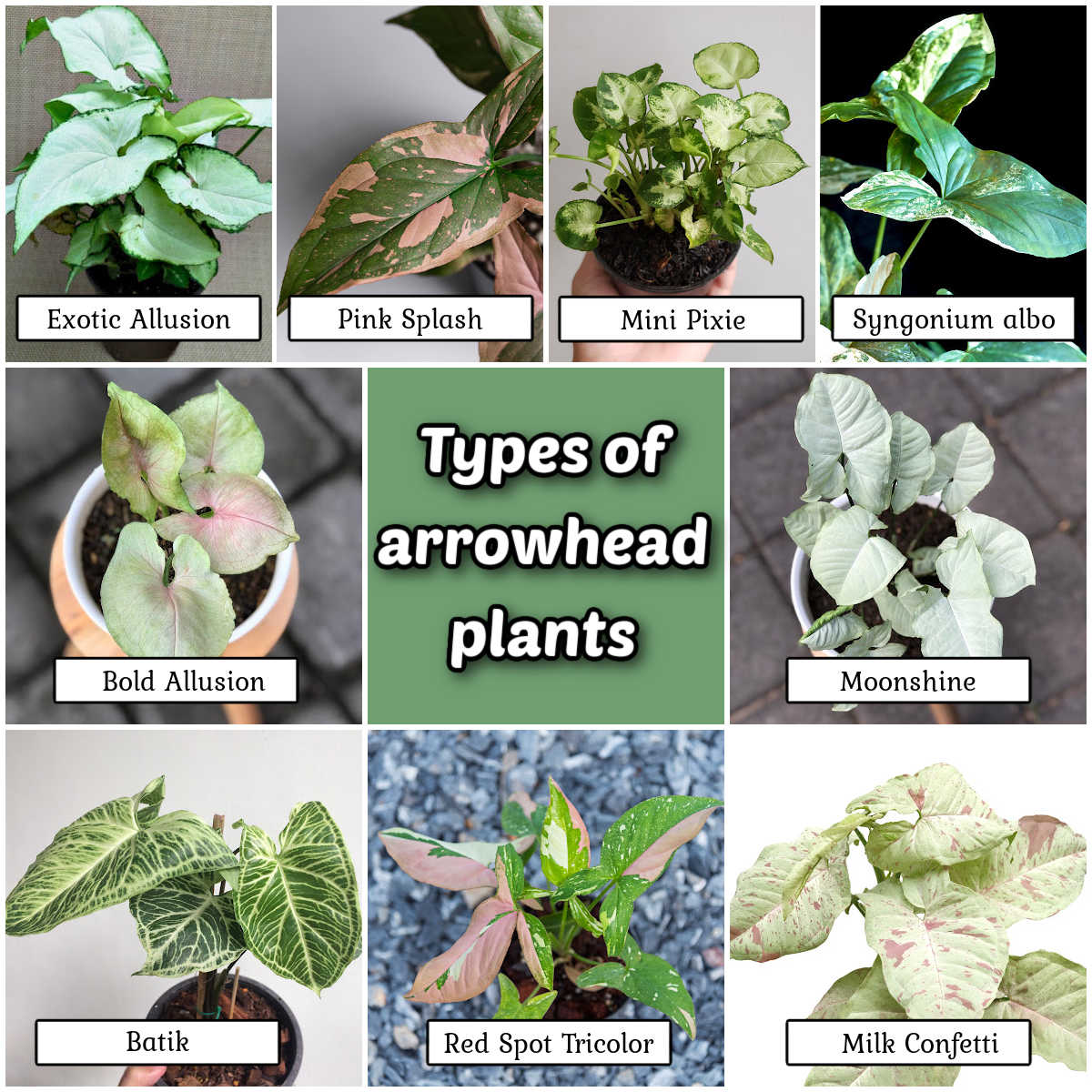
Feng shui practitioners believe that arrowhead plants are lucky plants. You can purchase an arrowhead Syngonium plant for your home from the links below.
- Syngonium Exotic Allusion – It has pale green leaves with dark green margins.
- Pink Splash – A delightful mix of pink and green splashes on the leaves.
- Mini Pixie – This tiny Syngonium grows in clumps.
- Syngonium podophyllum albo variegatum – This variety has vibrant green and white splotches on the leaves.
- Syngonium Bold Allusion – An arrowhead plant with pale green leaves and pink veins.
- Syngonium Moonshine – The leaves are almost-white with green margins. It’s a standout!
- Syngonium Batik – This variety has green leaves with prominent white veins.
- Syngonium Red Spot Tricolor – The deep green leaves have splashes of creamy white, vibrant pink or red.
- Syngonium Milk Confetti – The creamy white and green leaves have hints of pink or light red that create a confetti-like effect.
Get an arrowhead plant care printable
If you’d like a reminder of how to care for arrowhead plants, you can print out this care sheet as a high-resolution image. You can also get it from the project card at the bottom of the post in a slightly smaller size.
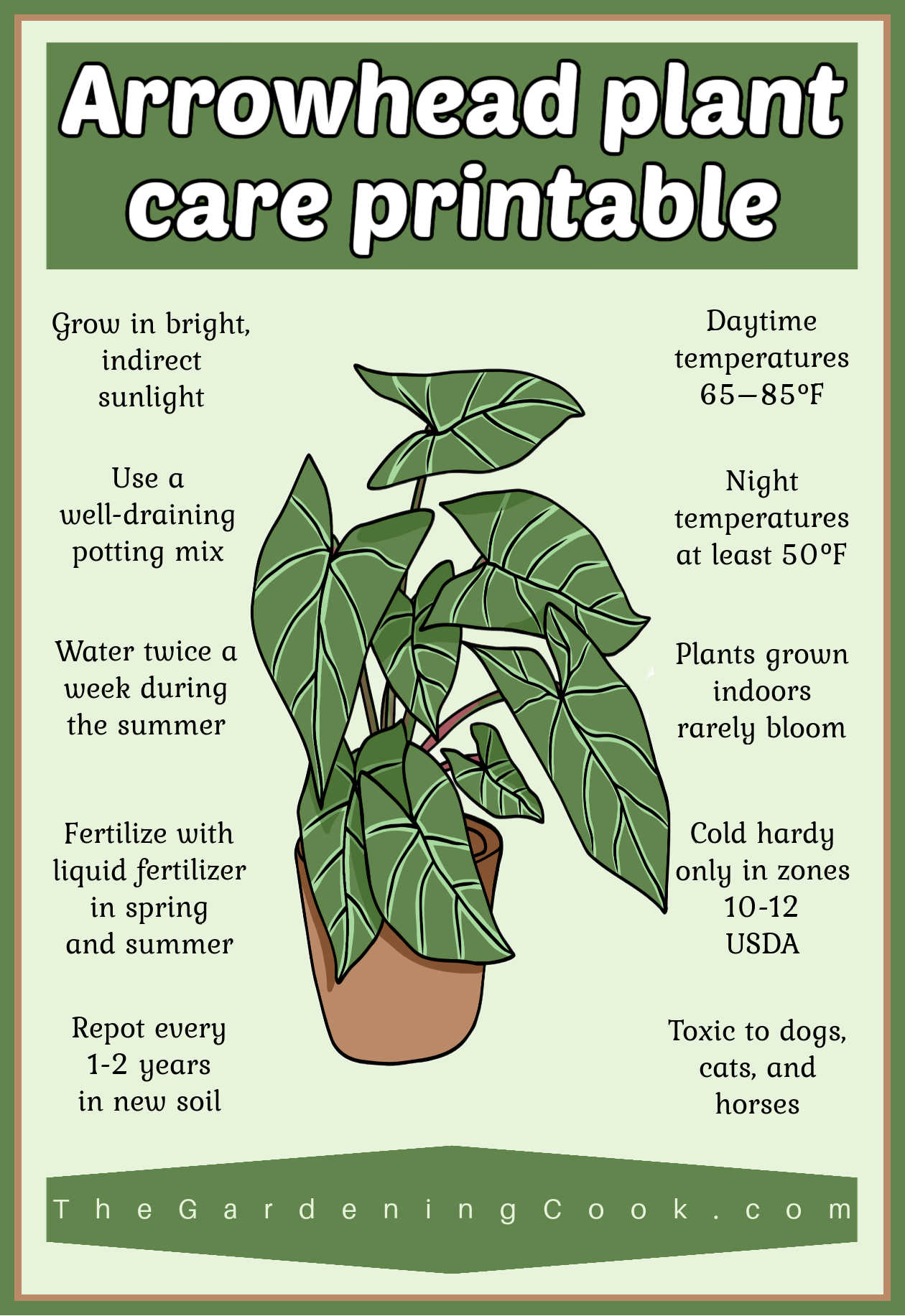
Share these tips for growing arrowhead plant on X
If you enjoyed learning how to grow Syngonium podophyllum, why not share this guide with a friend? Here is a post to get you started:
Syngonium podophyllum has leaves shaped like arrowheads. It doesn't mind low light and is an easy care houseplant. Find out how to grow arrowhead plants on The Gardening Cook. 🪴☀️💧 Share on XPin this post for taking care of an arrowhead plant
Would you like a reminder of this post for Syngonium care tips? Just pin this image to one of your gardening boards on Pinterest so that you can easily find it later.
If you enjoyed this post, you can also watch this YouTube video about growing arrowhead plants.

Admin note: This post was first published in July of 2013. It has been updated with new photos, a printable care card, and additional growing tips.
Arrowhead Plant Care Tips

Syngonium podophyllum is also known as an arrowhead plant, due to the shape of its leaves. It is an easy plant to grow; just follow the care tips below.
You can also print out an arrowhead care tips gardening printable for future reference.
Materials
- Syngonium plant
- Well-draining potting soil
- Liquid plant food
Tools
- Watering can
- Plant pot
Instructions
- Place the arrowhead plant in a bright spot with indirect sunlight. Keep it out of direct sun.
- The ideal temperature range is 65-85°F (18-27°C). Do not let the temperatures fall below 50°F (10°C).
- Use well-draining potting soil.
- Water the soil when it starts to become dry.
- In the winter when the plant is dormant, water less frequently.
- Fertilize monthly with a liquid food. Do not fertilize in the winter months.
- Repot into a larger pot once every 1-2 years.
- Prune often to make the plant more bushy.
- Propagate with stem cuttings in either soil or water.
Notes
In addition to the growing tips above, you can also print the image below from this card, or use this link to print it as a high-resolution image with the print feature of your browser window.

Recommended Products
As an Amazon Associate and member of other affiliate programs, I earn from qualifying purchases.
-
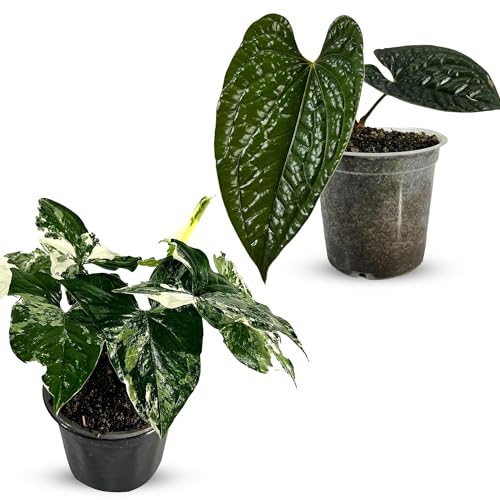 LEAL PLANTS ECUADOR Anthurium Luxurian & Syngonium Podophyllum Albo Variegated Live Plants
LEAL PLANTS ECUADOR Anthurium Luxurian & Syngonium Podophyllum Albo Variegated Live Plants -
 House Plant Shop | Syngonium 'White Butterfly' - 4" Pot | Live Indoor Plant | Easy to Care | Natural Décor Plant | Free Care Guide
House Plant Shop | Syngonium 'White Butterfly' - 4" Pot | Live Indoor Plant | Easy to Care | Natural Décor Plant | Free Care Guide -
 Syngonium Neon Pink - Live Plant in a 4 Inch Pot - -The Perfect Air Purifying Houseplant Companion
Syngonium Neon Pink - Live Plant in a 4 Inch Pot - -The Perfect Air Purifying Houseplant Companion